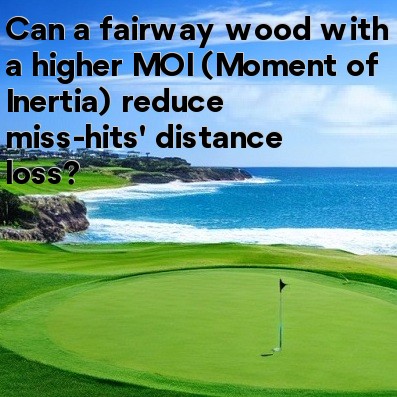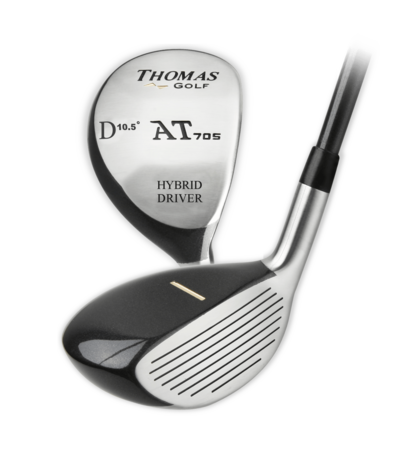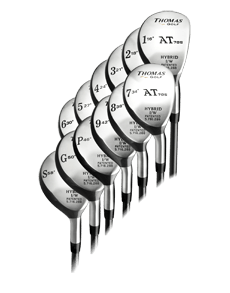
Can a Fairway Wood with a Higher MOI Reduce Miss-hits' Distance Loss?
 When it comes to golf equipment, advancements are continually being made to improve performance and enhance players' overall experience on the course. One key aspect that manufacturers constantly strive to improve is the Moment of Inertia (MOI) of golf clubs. MOI is a measure of an object's resistance to twisting and is particularly important in golf clubs, as it directly affects how off-center hits perform.
When it comes to golf equipment, advancements are continually being made to improve performance and enhance players' overall experience on the course. One key aspect that manufacturers constantly strive to improve is the Moment of Inertia (MOI) of golf clubs. MOI is a measure of an object's resistance to twisting and is particularly important in golf clubs, as it directly affects how off-center hits perform.
A fairway wood with a higher MOI is designed to reduce the loss of distance on miss-hits compared to those with a lower MOI. This is because a higher MOI increases the club's forgiveness, allowing it to resist twisting and provide better stability at impact. As a result, shots struck towards the toe or heel of the clubface, which would typically lose distance, may still retain a significant portion of their intended distance.
When a golfer hits a shot off-center, the clubhead tends to twist around its axis due to the force being applied away from the sweet spot. This can result in a loss of power and accuracy, leading to shots that fall short of the target. However, a higher MOI fairway wood helps counteract this twisting motion, ensuring more energy is transferred to the ball, even on off-center hits.
By distributing the weight around the clubhead strategically, golf club engineers can increase the MOI. This is typically achieved by placing more weight towards the perimeter of the clubhead, away from the center. The added weight on the outer edges creates more stability and reduces the tendency of the club to twist upon impact with the ball.
One common design feature found in fairway woods with higher MOI is a larger clubhead size. The larger head allows for more weight to be positioned away from the center, increasing the MOI. Additionally, these clubs often incorporate advanced materials such as carbon composites, which allow for even greater weight distribution enhancements.
It is important to note that while a fairway wood with a higher MOI can greatly reduce the distance loss on miss-hits, it does not completely eliminate the impact of an off-center strike. The amount of distance loss will still depend on various factors, including the severity of the miss-hit and the angle of the clubface at impact.
To maximize the benefits of a high MOI fairway wood, golfers should still strive to make consistent, center-face contact. However, knowing that their club is forgiving and has a higher MOI can provide players with added confidence, particularly in difficult situations.
- Higher MOI fairway woods reduce distance loss on off-center hits.
- Weight distribution and clubhead size are key factors in achieving higher MOI.
- Advanced materials can further enhance the distribution of weight.
- A high MOI fairway wood does not eliminate distance loss entirely.
In conclusion, a fairway wood with a higher MOI is a valuable addition to any golfer's bag. Its forgiveness and stability on off-center strikes can significantly reduce the distance loss typically associated with miss-hits. As technology advances, we can expect golf clubs with even higher MOI to continue making the game more enjoyable and accessible to players of all skill levels.
Update:
Can a fairway wood with a higher MOI (Moment of Inertia) reduce miss-hits’ distance loss?
Yes, fairway woods with a higher MOI (Moment of Inertia) can help reduce the distance loss on miss-hits. MOI is a measure of a club's resistance to twisting upon impact, which means that a higher MOI club will be more forgiving on off-center hits. Here's how a higher MOI fairway wood can reduce miss-hit distance loss:
- Increased Stability: Higher MOI fairway woods have more weight distributed around the perimeter of the clubhead, resulting in increased stability on off-center hits. This helps to minimize twisting of the clubhead at impact, leading to more consistent ball speeds and direction even on miss-hits.
- Consistent Distance: With a higher MOI, the fairway wood is less likely to lose significant distance on shots struck away from the center of the clubface. This consistency in ball speed across the face helps maintain distance on miss-hits, ensuring that the ball travels closer to the intended target.
- Improved Accuracy: A fairway wood with higher MOI provides greater forgiveness, allowing golfers to maintain accuracy even on shots that are struck slightly off-center. This can result in tighter dispersion patterns and fewer errant shots, leading to better overall performance on the course.
- Confidence Boost: Knowing that your fairway wood is forgiving on miss-hits can instill confidence in your swing. This confidence can lead to a more aggressive and consistent approach to your fairway wood shots, ultimately resulting in improved performance on the course.
- Better Launch Conditions: Higher MOI fairway woods often feature designs that promote optimal launch conditions, such as a lower center of gravity (CG) and a higher trajectory. These launch characteristics can help maximize carry distance and overall distance, even on miss-hit shots.
10 Q&A On Can a fairway wood with a higher MOI (Moment of Inertia) reduce miss-hits’ distance loss?
- Q: What is Moment of Inertia (MOI) in golf clubs?
- A: Moment of Inertia (MOI) is a measure of a club's resistance to twisting upon impact. In golf clubs, a higher MOI indicates greater forgiveness on miss-hits.
- Q: How does a higher MOI fairway wood differ from a lower MOI one?
- A: A fairway wood with a higher MOI is more forgiving on miss-hits compared to one with a lower MOI. Higher MOI fairway woods tend to provide more consistent distance and direction, especially on off-center strikes.
- Q: Can a higher MOI fairway wood completely eliminate distance loss on miss-hits?
- A: While a higher MOI fairway wood can significantly reduce distance loss on miss-hits, it cannot completely eliminate it. However, it can greatly minimize the distance loss compared to a lower MOI club.
- Q: Are there any drawbacks to using a fairway wood with a higher MOI?
- A: Generally, there are no significant drawbacks to using a fairway wood with a higher MOI. However, some golfers may prefer the feel or workability of lower MOI clubs, so it ultimately comes down to personal preference.
- Q: How can I determine if a fairway wood has a high MOI?
- A: Golf club manufacturers often provide information about the MOI of their clubs in product specifications. Additionally, club reviews and fitting sessions can provide insights into the forgiveness and MOI characteristics of specific fairway woods.
- Q: Do professional golfers use fairway woods with higher MOI?
- A: Many professional golfers, including those on the PGA Tour, use fairway woods with higher MOI to benefit from the added forgiveness and consistency, especially on demanding courses and under pressure situations.
- Q: Can a higher MOI fairway wood help golfers with slower swing speeds?
- A: Yes, golfers with slower swing speeds can benefit from using fairway woods with higher MOI, as they provide more forgiveness and consistency on off-center hits, resulting in better overall performance.
- Q: Are there any specific swing techniques that complement the use of higher MOI fairway woods?
- A: While there are no specific swing techniques tailored to higher MOI fairway woods, maintaining good fundamentals and a smooth, consistent swing can help maximize the benefits of forgiveness and consistency offered by these clubs.
- Q: Can adjusting the weight configuration of a fairway wood affect its MOI?
- A: Yes, adjusting the weight configuration of a fairway wood can impact its MOI. Placing more weight towards the perimeter of the clubhead can increase MOI and enhance forgiveness on off-center hits.
- Q: Should golfers prioritize MOI when choosing a fairway wood?
- A: MOI is an important factor to consider when choosing a fairway wood, especially for golfers who value forgiveness and consistency. However, factors such as feel, trajectory, and shot shape preferences should also be taken into account during the club selection process.





